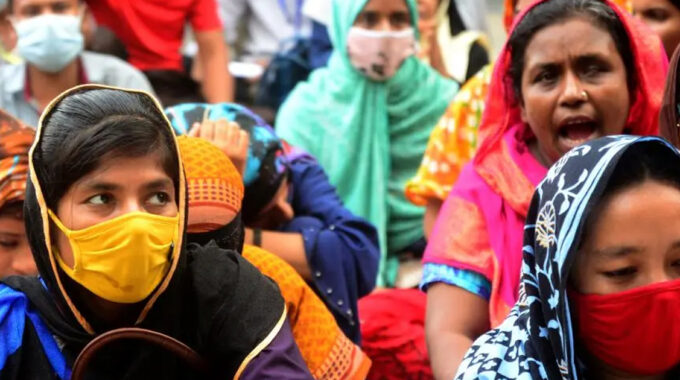How Bangladesh’s economy has fared during the covid-19 pandemic: critical measures taken by the government

Efforts taken by Bangladesh’s economy during the pandemic
The world was doing just fine when the virus came and destroyed the global economy. The COVID-19 virus started to spread in the last two months of the year 2019 and has not stopped till now. The virus forced people to stay at their homes, shut their businesses and therefore hampered the growth of the world. While many countries failed miserably to contain the virus, some countries were very successful.

They successfully managed to contain the virus while keeping in mind the growth of the economy. No, India does not belong to this list. One such country has aced its economic performance during the pandemic year. The growth of Bangladesh is very commendable and is surely expected to grow by huge numbers in the coming years.
During the pandemic year of 2020, the Bangladesh government made commendable efforts which resulted in its success during the year. The country was able to contain the virus as well as manage its economic activities, therefore helping the country to grow.

The country’s economic progress was recently recognised in Bloomberg’s COVID-19 resilience ranking, where it was ranked 24th out of the 53 economies listed which is worth nearly $200 billion. Bangladesh’s recognition in the list has proved that its progress has been very commendable. In one World Bank report, it was said that despite the uncertainty caused by the pandemic, the outlook for Bangladesh’s economy is positive.
Not only economic performance, but Bangladesh also addressed another issue that prevails in literally every country, the problem of unemployment. The country launched various stimulus packages in order to keep people employed during the pandemic, which helped people to survive easily. Unlike them, India failed to provide employment to its people which created the problem of financial crisis among the people. This has led to the development of faith and confidence in the minds of the people of Bangladesh.

However, Bangladesh was not always like this. Once seen as the epitome of poverty and hunger, nobody expected Bangladesh to be the hero. The economy of Bangladesh has seen huge changes in the last few years with huge growth in its GDP. Its stable GDP growth in the last few years have provided optimistic hopes for the country’s future. It was once labelled as a basket case, which meant that it would never be able to grow. But look at it now, nothing just growing and growing. It is expected to become the Asian tiger- which is completely opposite of the previous term. The constant growth of the country has been very beneficial to its people.
When the IMF projections came out, everyone was shocked to the core. According to the projections of IMF, Bangladesh’s per capita income was said to rise by 4% to 1,888 US dollars while, on the other hand, India’s per capita income was said to fall by 10.57% to 1,877 US dollars in the year 2020. Moreover, you can’t just blame the pandemic for this. Even before the pandemic, India’s GDP has been constantly sliding down from 6.7% in 2017 to 6.53% in the next year and to 4.53% in the year 2019 and lastly crashed to -7% in the year 2020.
On the other hand, the growth of Bangladesh has been constantly rising. It was listed as the world’s seventh fastest-growing economy. Its GDP was steadily rising every day which led to crossing the 8% level. Moreover, Bangladesh achieved this level even while facing fiscal pressures because of many factors, such as the donor fatigue in response to the Rohingya crisis as well as revenue shortfall from an outdated tax administration. The major factors responsible for elevating poverty in Bangladesh are fiscal prudence and the performance of the export sector.
The cottage industries played such a major role in the development of Bangladesh that they are now a part of the MSME category making it a cottage, micro, small and medium-sized enterprise (CMSME). It employed nearly 7.8 million people and contributes a huge amount to the total GDP level, 25 per cent. Bangladesh has been very supportive of its CMSME which can be clearly seen by their decision of financing the UNSECO approved Bangabandhu Sheikh Mujibur Rehman International Prize for the creative economy for its outstanding progress promoting young people in the creative economy. India has to take lessons from Bangladesh to manage the MSMEs.
Apart from MSMEs, Bangladesh has been very successful in developing a strong export sector to manage the competitive exports, which India can learn from. Speaking about India, its top five export commodities contribute to 40% of the total exports. It’s micro and small enterprises are suffering due to failure of getting easy loans. Also, there has been a constant decrease in India:₹ labour extensive industries which is directly affecting the export-oriented industries such as garments, textiles and leather.
For the majority of the small and medium enterprises, the availability of finance from the formal sector is very less hence forcing them to rely more on the informal sector for loans, which is never good for the development of a country. New industries require huge loans to set up and finance their work, but due to the inefficient banking system of the country, it has become difficult.
In India, the condition of the economy was bad even before the virus broke out, majorly due to the inefficient management of the policies such as GST, demonetisation and strict e-commerce rules. It hampered the Indian industries to fight with big industries of the world and therefore led to the failure of the development of the economy. CAIT reports a loss of nearly Rs 15 lakh crores of business in the last two months because of the state-based lockdowns imposed in the country. This number is huge. There is a need to rescue to the small and rural businesses which have been adversely affected by the pandemic and the prolonged lockdowns.
Like the various stimulus packages launched by Bangladesh in order to provide jobs to the people, India needs to launch these policies too, in order to protect its people financially from the effect of the virus. Like any other country, Bangladesh has also been aiming to make progress in the digital sector, making it’s economy a digital economy. India, on the other hand, has been aiming for the same. The progress of Bangladesh is very commendable. The population of Bangladesh is huge but still, they managed to grow, just in such a short period of time. and for India to become the hero of Asia, the need to learn from them rises.
Edited by Aishwarya Ingle




